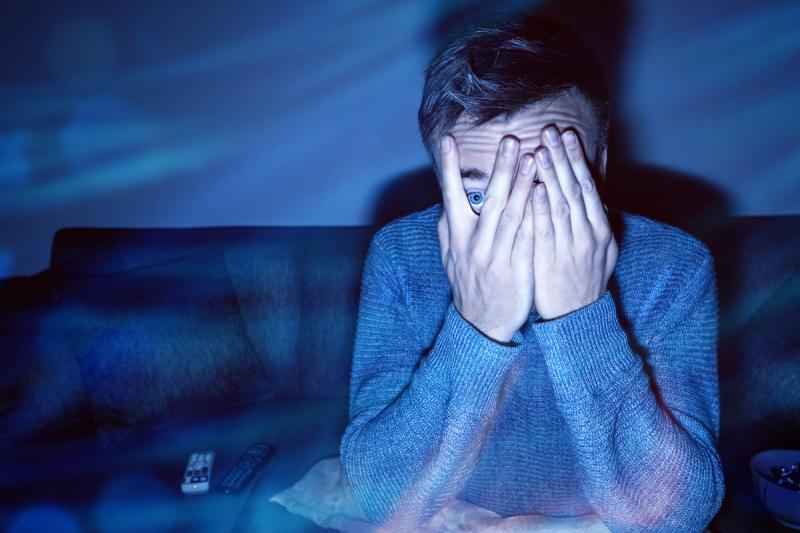The Ghastly Spell of Horror Entertainment

In this season of all things ghoulish, as the legendary veil between life and afterlife thins and days grow shorter, dark nights longer, many of us reach for the TV remote for a dose of horror as reflexively as that bowl of Halloween candy.
What lures us to horror storytelling? Is there something inherently human in our desire to scare ourselves? What does the horror genre in film and TV say about our moment in time and personal and collective demons?
Safely Navigating the Horrors Within
“A simple answer from the psychology of aesthetics is that people are drawn to things which capture their attention and emotional things, especially negative, do that,” said Professor Kateri McRae, Department of Psychology. “For a long time, emotion scientists have noticed that people will voluntarily engage in very controlled activities that simulate what would otherwise be really disturbing real-world experiences.”
Like scary rides in an amusement park and video and virtual-reality games with disturbing content, horror movies enable us to feel extreme emotions in a safe environment.
“There’s a hypothetical or representational distance where you’re getting all kinds of cues that this isn’t real, layered on top of the screams and the blood on the screen that help you through it,” McRae said, likening the experience to playing pretend.
“That wrapper of safety allows you to get all your emotional machinery going, your heart and blood pumping, your scream muscles working, without feeling like you are personally in danger. There’s also something about being able to stop, start and pause that allows you to tolerate what you otherwise would not voluntarily sign up for.”
Capturing Cultural Dramas and Traumas
Lauren DeCarvalho, associate professor in the Department of Media, Film and Journalism Studies (MFJS), who currently teaches a class on horror film, said the genre “addresses our cultural fears and anxieties, and often focuses on ‘the return of the repressed’ and those who are deemed inferior or subordinate in society.”
We can use horror films to better understand the relationship between “normality” and the “Other” in a given society, DeCarvalho explained.
“One of the things that draws people to horror films and keeps them timely is that cultural fears themselves are pretty much the same—fear of death, fear of the unknown, fear of the ‘Other.’ But depending on the cultural zeitgeist you can address them differently, in remakes, for example.”
She cites the original 1978 John Carpenter movie Halloween.
“Twenty plus years later you have Rob Zombie’s 2007 version that really gives backstory to [villain] Michael Myers. It doesn’t just justify his actions but gives us insight into who he was and represents a shift in who we identify with onscreen,” DeCarvalho said.
Traditional horror depicts those deemed “different, subordinate or marginalized as villains,” DeCarvalho said. “Nowadays you have a centering of the previously marginalized group. The fears are the same but because of a shift in cultural climate you identify with once villainized characters.”
DeCarvalho references Jordan Peele’s recent movie Nope, that probes fears about the digitalization of society, the surveillance state and the unknown, in which the protagonists are Black, as an example in which “the racialized ‘Other’ is in a leadership role.”
She believes there’s a universal attraction to being scared expressed in horror movies around the world “but the context you’re raised in determines who is seen as different. Horror films play on those fears which is why these films are good at addressing issues of immigration, national traumas and economic precarity.”
Movies like the 2017 film It Comes at Night, for example, “look at issues of immigration and fears about undocumented citizens in a story about people forced to share a house and afraid to go outside after an apocalyptic event,” DeCarvalho said.
Recommendations for Horror Viewing
When it comes to her personal favorites, “you can’t go wrong with George Romero’s 1968 Night of the Living Dead,” DeCarvalho said. “The film was well ahead of its time with a Black man as a protagonist, its commentary on race riots and how news wasn’t covering police brutality toward members of African American communities.”
Her tastes veer toward international films like the 2014 Australian movie Babadook.
“It showcases a woman who lost her husband, how her grief manifests as a monster and impacts her son who’s terrified of grief because his mom is nowhere to be found so to speak.”
DeCarvalho also recommends the 2005 British film The Descent that provides a fresh spin on women characters, the 2002 Japanese film Dark Water and the 2014 Iranian-American film A Girl Who Walks Home at Night.
“A young woman known as ‘the girl’ is walking home at night but it turns the tables because she’s a vampire who puts in place those who hurt women. She’s able to navigate those spaces because she’s kind of anonymous and no one pays attention to women in [Iranian/Iranian-American] society.”
DeCarvalho advises her students to use horror films like any other narrative as “a vessel for self-discovery and reflection” and a way to better understand our own culture and cultures around the world.
“We’re raised to know what we know and judge what is different as against what we might believe. Horror films help us identify and reflect on those fears.”
Note: You can access many streamed films and TV shows through the University of Denver Library’s Streamed Media.


